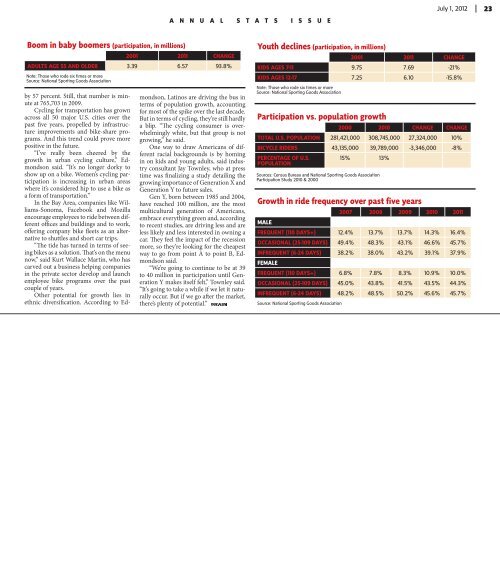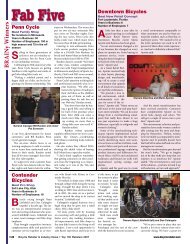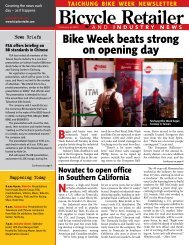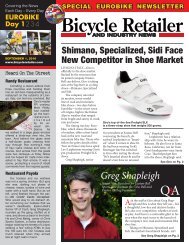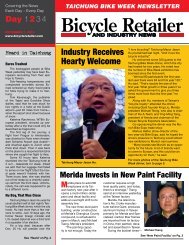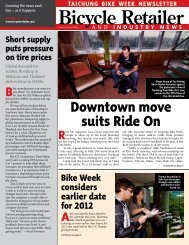Create successful ePaper yourself
Turn your PDF publications into a flip-book with our unique Google optimized e-Paper software.
Boom in baby boomers (participation, in millions)<br />
2001 2011 CHANGE<br />
ADULTS AGE 55 AND OLDER 3.39 6.57 93.8%<br />
Note: Those who rode six times or more<br />
Source: National Sporting Goods Association<br />
by 57 percent. Still, that number is minute<br />
at 765,703 in 2009.<br />
Cycling for transportation has grown<br />
across all 50 major U.S. cities over the<br />
past five years, propelled by infrastructure<br />
improvements and bike-share programs.<br />
And this trend could prove more<br />
positive in the future.<br />
“I’ve really been cheered by the<br />
growth in urban cycling culture,” Edmondson<br />
said. “It’s no longer dorky to<br />
show up on a bike. Women’s cycling participation<br />
is increasing in urban areas<br />
where it’s considered hip to use a bike as<br />
a form of transportation.”<br />
In the Bay Area, companies like Williams-Sonoma,<br />
Facebook and Mozilla<br />
encourage employees to ride between different<br />
offices and buildings and to work,<br />
offering company bike fleets as an alternative<br />
to shuttles and short car trips.<br />
“The tide has turned in terms of seeing<br />
bikes as a solution. That’s on the menu<br />
now,” said Kurt Wallace Martin, who has<br />
carved out a business helping companies<br />
in the private sector develop and launch<br />
employee bike programs over the past<br />
couple of years.<br />
Other potential for growth lies in<br />
ethnic diversification. According to Ed-<br />
A N N U A L S T A T S I S S U E<br />
mondson, Latinos are driving the bus in<br />
terms of population growth, accounting<br />
for most of the spike over the last decade.<br />
But in terms of cycling, they’re still hardly<br />
a blip. “The cycling consumer is overwhelmingly<br />
white, but that group is not<br />
growing,” he said.<br />
One way to draw Americans of different<br />
racial backgrounds is by homing<br />
in on kids and young adults, said industry<br />
consultant Jay Townley, who at press<br />
time was finalizing a study detailing the<br />
growing importance of Generation X and<br />
Generation Y to future sales.<br />
Gen Y, born between 1985 and 2004,<br />
have reached 100 million, are the most<br />
multicultural generation of Americans,<br />
embrace everything green and, according<br />
to recent studies, are driving less and are<br />
less likely and less interested in owning a<br />
car. They feel the impact of the recession<br />
more, so they’re looking for the cheapest<br />
way to go from point A to point B, Edmondson<br />
said.<br />
“We’re going to continue to be at 39<br />
to 40 million in participation until Generation<br />
Y makes itself felt,” Townley said.<br />
“It’s going to take a while if we let it naturally<br />
occur. But if we go after the market,<br />
there’s plenty of potential.”<br />
Youth declines (participation, in millions)<br />
July 1, 2012<br />
2001 2011 CHANGE<br />
KIDS AGES 7-11 9.75 7.69 -21%<br />
KIDS AGES 12-17 7.25 6.10 -15.8%<br />
Note: Those who rode six times or more<br />
Source: National Sporting Goods Association<br />
Participation vs. population growth<br />
2000 2010 CHANGE CHANGE<br />
TOTAL U.S. POPULATION 281,421,000 308,745,000 27,324,000 10%<br />
BICYCLE RIDERS 43,135,000 39,789,000 -3,346,000 -8%<br />
PERCENTAGE OF U.S.<br />
POPULATION<br />
15% 13%<br />
Sources: Census Bureau and National Sporting Goods Association<br />
Participation Study 2010 & 2000<br />
Growth in ride frequency over past five years<br />
MALE<br />
2007 2008 2009 2010 2011<br />
FREQUENT (110 DAYS+) 12.4% 13.7% 13.7% 14.3% 16.4%<br />
OCCASIONAL (25-109 DAYS) 49.4% 48.3% 43.1% 46.6% 45.7%<br />
INFREQUENT (6-24 DAYS) 38.2% 38.0% 43.2% 39.1% 37.9%<br />
FEMALE<br />
FREQUENT (110 DAYS+) 6.8% 7.8% 8.3% 10.9% 10.0%<br />
OCCASIONAL (25-109 DAYS) 45.0% 43.8% 41.5% 43.5% 44.3%<br />
INFREQUENT (6-24 DAYS) 48.2% 48.5% 50.2% 45.6% 45.7%<br />
Source: National Sporting Goods Association<br />
23


